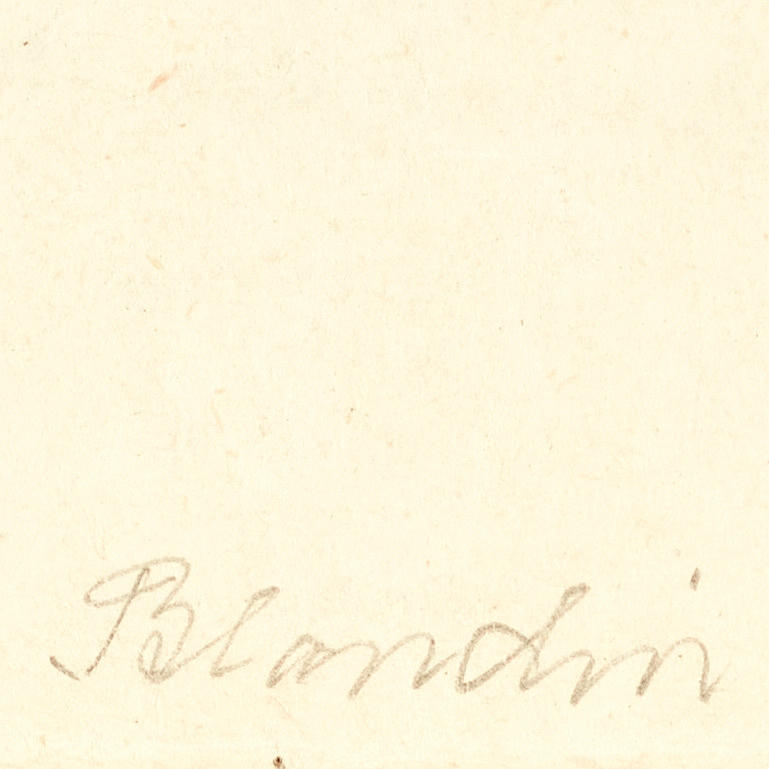
AXEL FRIDELL (1894-1935), "The Blonde/Girl in the Window II”, signed in pencil, dry needle.
This auction is closed, but maybe you like the following items?





Description
Haskel 308, II état, without plate signature on top.
blade dimensions 50x33 cm,
Picture area 30x20 cm
AXEL FRIDELL
The Falun of his childhood, where Axel Fridell grew up, did not offer much artistic variety. Even so, as a fifteen-year-old, he was determined to become an artist. An event that illustrates the fervent interest is when Axel cycled 5 miles - easy direction - to show his artistic works to the famous artist Gustaf Ankarcrona, who lived in Tällberg.
When Axel eventually sought his artistic education in Stockholm in 1913, he chose the more traditional Art Academy, even though many of his contemporaries applied to the oppositional Artists' Association's school. Fridell, however, thrived at the Academy and then especially in the etching studio. Unlike many of his colleagues, he was not impressed by the Matisse students a few years older and their influence by French Expressionism. He himself was greatly inspired by Ivar Arosenius, whose memorial exhibition at the Academy in 1909 made a strong impression on Fridell and his friends. Other house gods included Pascin, Aubrey Beardsley, and Edvard Munch.
When the First World War came to a close in the late summer of 1914, Fridell and two friends rented a studio at Kungsbroplan and continued their studies at the Academy rather carefree. Axel Fridell had his first exhibition in the same year together with Bertil Bull Hedlund in a bookstore in Falun. Now began a period of intense entertainment and a poor bohemian life. Like Toulouse-Lautrec, whom Fridell also admired, he preferred to spend his time in somewhat dubious environments of the simpler kind.
In 1916 Fridell and his artist friend Bertil “Bull” Hedlund were expelled from the Academy of Fine Arts for “negligence in their studies”.
Fridell came to the attention of the art critic August Brunius during a show in Stockholm in 1917, which meant that the demand for his graphics increased. In 1918, together with Tägtström and Detthow, he participated in an exhibition at the Academy of Fine Arts. During the 1920s Fridell made trips to Italy and France, before settling in both Falun and Stockholm for different periods.
Above all, Axel Fridell has taken a place in Swedish art history as one of our most prominent etchers.
Condition
unframed, slightly wavy at the top,
Less edge wear.
Theme
Do you have something similar to sell? Get your items valued free of charge!
Bidding
Have your item valued free of charge.
Bid history
| 7 | 4 Nov, 11:05 | 229 EUR |
| The reserve price of 229 EUR was met. | ||
| 6 | 23 Oct, 15:01 | 156 EUR |
| 5 | 22 Oct, 14:08 | 146 EUR |
| Show all 8 bids | ||
Description
Haskel 308, II état, without plate signature on top.
blade dimensions 50x33 cm,
Picture area 30x20 cm
AXEL FRIDELL
The Falun of his childhood, where Axel Fridell grew up, did not offer much artistic variety. Even so, as a fifteen-year-old, he was determined to become an artist. An event that illustrates the fervent interest is when Axel cycled 5 miles - easy direction - to show his artistic works to the famous artist Gustaf Ankarcrona, who lived in Tällberg.
When Axel eventually sought his artistic education in Stockholm in 1913, he chose the more traditional Art Academy, even though many of his contemporaries applied to the oppositional Artists' Association's school. Fridell, however, thrived at the Academy and then especially in the etching studio. Unlike many of his colleagues, he was not impressed by the Matisse students a few years older and their influence by French Expressionism. He himself was greatly inspired by Ivar Arosenius, whose memorial exhibition at the Academy in 1909 made a strong impression on Fridell and his friends. Other house gods included Pascin, Aubrey Beardsley, and Edvard Munch.
When the First World War came to a close in the late summer of 1914, Fridell and two friends rented a studio at Kungsbroplan and continued their studies at the Academy rather carefree. Axel Fridell had his first exhibition in the same year together with Bertil Bull Hedlund in a bookstore in Falun. Now began a period of intense entertainment and a poor bohemian life. Like Toulouse-Lautrec, whom Fridell also admired, he preferred to spend his time in somewhat dubious environments of the simpler kind.
In 1916 Fridell and his artist friend Bertil “Bull” Hedlund were expelled from the Academy of Fine Arts for “negligence in their studies”.
Fridell came to the attention of the art critic August Brunius during a show in Stockholm in 1917, which meant that the demand for his graphics increased. In 1918, together with Tägtström and Detthow, he participated in an exhibition at the Academy of Fine Arts. During the 1920s Fridell made trips to Italy and France, before settling in both Falun and Stockholm for different periods.
Above all, Axel Fridell has taken a place in Swedish art history as one of our most prominent etchers.
Condition
unframed, slightly wavy at the top,
Less edge wear.
Theme
Do you have something similar to sell? Get your items valued free of charge!








